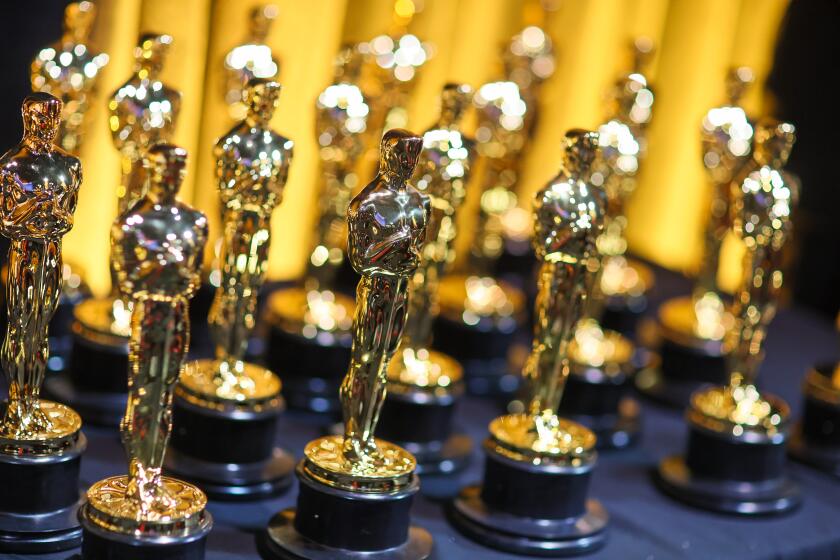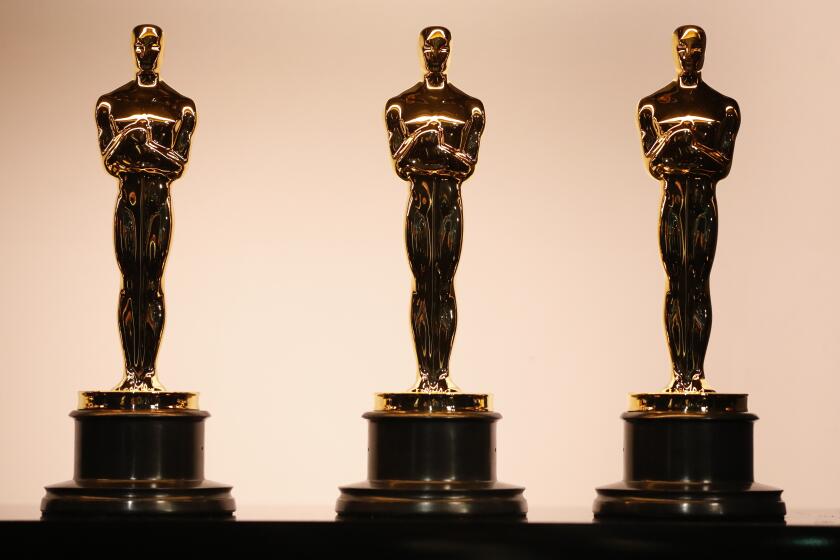A Model Surrealist
- Share via
The classic Dada artist Man Ray holds a special, if somewhat walleyed, fascination for Los Angeles. That interest is piqued by the Getty Center exhibition “A Practical Dreamer: The Photographs of Man Ray.”
Accompanied by one of the Getty’s invaluable “In Focus” monographs, the show was selected by assistant curator Katherine Ware. Nearly 100 mint-condition prints represent just a third of the Getty’s collection, placing it among the most important compendiums of Man Ray’s camera works.
Born in 1890, the artist grew up in Brooklyn as Emmanuel Radnitsky. When his family shortened the surname to Ray, he changed his nickname, Manny, to Man, thus the odd Hollywood-sounding moniker.
The exhibition divides into sections for Ray’s periods in New York, Paris and L.A. Early Manhattan compositions were influenced first by Alfred Stieglitz, then by the iconoclastic aesthetic of Marcel Duchamp. Ray’s 1916 “Self Portrait” records an assemblage including a doorbell button, its ringer, a handprint and the drawn f-shaped holes of a violin. Today, with its shock value nullified by time, the piece functions as a sweet, well-made little gag.
It also acts as a reminder that the artist was painter, sculptor and filmmaker as well as a photographer. Wearing the latter hat, he established a lucrative sideline doing fashion shots and portraits. Again, time has virtually erased the border between what he regarded as serious and commercial effort. He was too conscientious a craftsman to do a sloppy job.
Ray moved to Paris in 1921, where he did his best work. Prodigious, he did early color experiments and discovered a method of camera-free photography, christening his version the “Rayograph.” Results, such as a portfolio called “The Delicious Fields,” coax magical abstract images from nothing more than coils of paper exposed to photo-sensitized surfaces.
We see trademark images like the ironic “Tears” showing a woman’s eyes crying little glass balls. The artist’s mistress, Kiki, posed for “Ingres’ Violin.” Her nude back is made to suggest a stringed instrument by the addition of f-holes on either side of her spine. One wonders if the recurrent use of the f-hole also stands for the camera’s f-stop.
If Ray’s portraits are less inventive, they’re nonetheless valuable as both art and document. Images of photographer Bernice Abbott and painter Joseph Stella, as well as authors including Gertrude Stein and James Joyce, record a generation of genius. Ray’s touch glamorizes without making artificial. He took the most memorable shots of Duchamp in drag as his female alter ego Rrose Selavy. His unrepeatable deathbed study of Marcel Proust’s profile is solemnly, unsentimentally moving.
In 1940, after Hitler’s troops occupied the French capital, Ray beat it home, joining Salvador Dali on a steamer from Lisbon. Ray’s interest in cinema magnetized him to Hollywood. He soon found that the collaborative nature of commercial film wasn’t his dish, even though he made friends in the industry as well as in the emigre art community. He married a beautiful young dancer, Juliet Browner, who became his principal model. They settled into the Villa Elaine on Vine Street.
Ray’s L.A. photos are by no means a bust, but they do reflect a period when he was understandably troubled. The still life “Ruth, Roses and Revolvers” illustrated a piece of short fiction he published. The story was used as part of the plot for the film “Dreams That Money Can Buy,” but the photo itself is an image of dying hope and power rendered useless.
A portrait of Mexican film star Dolores del Rio is as slick as a studio shot. Images of his wife playing various roles include “Juliet With Vines,” for which she’s convincingly cast as an impish nymph.
In 1951, the couple moved to Paris. Ray couldn’t have been entirely miserable during his decade in Tinseltown: He had companions, held exhibitions, lectured and made art, if little money. Departure was certainly partly practical, partly a matter of the superior status Europeans accord artists.
I suspect another, subtler motive. Ray once remarked, “There was more Surrealism rampant in Hollywood than all the Surrealists could invent in a lifetime.”
Maybe Ray just felt a little redundant around here.
* “A Practical Dreamer: The Photographs of Man Ray,” the J. Paul Getty Museum at the Getty Center, 1200 Getty Center Drive; through Jan. 17. Parking reservations: (310) 440-7300. Closed Mondays.
More to Read
The biggest entertainment stories
Get our big stories about Hollywood, film, television, music, arts, culture and more right in your inbox as soon as they publish.
You may occasionally receive promotional content from the Los Angeles Times.










